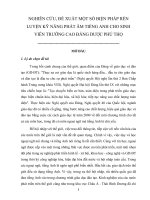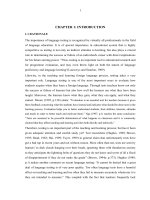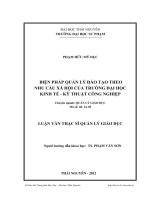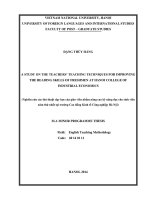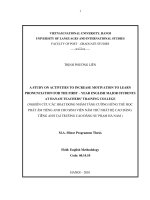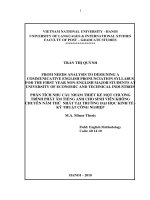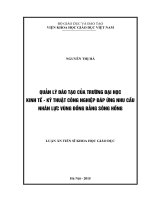Phân tích nhu cầu nhằm thiết kế một chương trình phát âm tiếng Anh cho sinh viên không chuyên năm thứ nhất tại Trường Đại học Kinh tế - Kỹ thuật Công nghiệp
Bạn đang xem bản rút gọn của tài liệu. Xem và tải ngay bản đầy đủ của tài liệu tại đây (796.9 KB, 58 trang )
1
VIETNAM NATIONAL UNIVERSITY - HANOI
UNIVERSITY OF LANGUAGES & INTERNATIONAL STUDIES
FACULTY OF POST – GRADUATE STUDIES
*****************
TRẦN THỊ QUỲNH
FROM NEEDS ANALYSIS TO DESIGNING A
COMMUNICATIVE ENGLISH PRONUNCIATION SYLLABUS
FOR THE FIRST YEAR NON-ENGLISH MAJOR STUDENTS AT
UNIVERSITY OF ECONOMIC AND TECHNICAL INDUSTRIES
PHÂN TÍCH NHU CẦU NHẰM THIẾT KẾ MỘT CHƯƠNG
TRÌNH PHÁT ÂM TIẾNG ANH CHO SINH VIÊN KHÔNG
CHUYÊN NĂM THỨ NHẤT TẠI TRƯỜNG ĐẠI HỌC KINH TẾ -
KỸ THUẬT CÔNG NGHIỆP
M.A. Minor Thesis
Field: English Methodology
Code: 60 14 10
HANOI – 2010
2
VIETNAM NATIONAL UNIVERSITY - HANOI
UNIVERSITY OF LANGUAGES & INTERNATIONAL STUDIES
FACULTY OF POST – GRADUATE STUDIES
*****************
TRẦN THỊ QUỲNH
FROM NEEDS ANALYSIS TO DESIGNING A
COMMUNICATIVE ENGLISH PRONUNCIATION SYLLABUS
FOR THE FIRST YEAR NON-ENGLISH MAJOR STUDENTS AT
UNIVERSITY OF ECONOMIC AND TECHNICAL INDUSTRIES
PHÂN TÍCH NHU CẦU NHẰM THIẾT KẾ MỘT CHƯƠNG
TRÌNH PHÁT ÂM TIẾNG ANH CHO SINH VIÊN KHÔNG
CHUYÊN NĂM THỨ NHẤT TẠI TRƯỜNG ĐẠI HỌC KINH TẾ -
KỸ THUẬT CÔNG NGHIỆP
M.A. Minor Thesis
Field: English Methodology
Code: 60 14 10
Supervisor: Nguyễn Minh Huệ, M.A
HANOI – 2010
6
TABLE OF CONTENTS
Declaration i
Acknowledgement ii
Abstract iii
Table of contents iv
Lists of tables and charts
vii
List of abbreviation
vii
i
Appendices
ix
CHAPTER ONE: INTRODUCTION
1.1. Rational of the study
1
1.2. Aims of the study
2
1.3. Scope of the study
2
1.4. Significance of the study
3
1.5. Structure of the study
3
CHAPTER TWO: LITERATURE REVIEW
2.1. Language syllabus design
4
7
2.1.1. Syllabus and curriculum
4
2.1.2. Some major approaches in designing a syllabus
4
2.1.2.1. Synthetic strategy
5
2.1.2.2. Analytic strategy
5
2.1.3. Three principal types of language syllabus
5
2.1.3.1. Structural syllabus 5
2.1.3.2. Situational syllabus
6
2.1.3.3. Notional-functional syllabus 6
2.1.4. Essential steps in designing a language syllabus
7
2.1.4.1. Needs background 7
2.1.4.1.1. Needs analysis 7
2.1.4.1.2. Resources analysis
8
2.1.4.2. Goal setting 8
2.1.4.3. Selecting and grading content 9
2.1.4.3.1. Selecting the content 9
2.1.4.3.2. Grading the content 10
2.1.4.4. Selecting and grading tasks and activities 10
2.1.4.4.1. Selecting tasks 10
2.1.4.4.2. Grading tasks 11
8
2.1.4.5. Teaching method 12
2.1.4.6. Testing – Evaluation 12
2.2. Communicative pronunciation teaching 12
2.2.1. Pronunciation and communicative teaching 12
2.2.2. History and scope of teaching English pronunciation 13
CHAPTER THREE: METHODOLOGY
3.1. The setting of the study 15
3.2. Participants 15
3.3. Data collection methods 16
3.3.1. Questionnaire 16
3.3.2. Mock speaking test 17
3.3.3. Interview 17
3.4. Data collection procedure 18
3.5. Data analysis 18
CHAPTER FOUR: FINDINGS AND DISCUSSIONS
4.1. Students‟ expectations 19
4.1.1. The student‟s expectations towards teachers of pronunciation . 19
4.1.2. Students‟ expectations towards materials exploited in
pronunciation 19
4.2. Students‟ attitude towards the pronunciation 20
4.3. Students‟ problems with English pronunciation 21
4.3.1. Students‟ problems with English consonants 23
4.3.2. Students‟ problems with English vowel 25
4.3.3. Students‟ problems with English weak forms / linkage words . 26
4.3.4. Students‟ problems with English stress / intonation 26
4.4. Teachers‟ perception of teaching pronunciation and their assessment of
the existing materials 27
9
4.5. Curricular and Materials Analysis 29
CHAPTER FIVE: A PROPOSED SYLLABUS OF ENGLISH
PRONUNCIATION
5.1. Introduction 32
5.2. Goals and objectives 32
5.2.1. Goals 32
5.2.2. Objectives 32
5.3. The content 32
5.4. Teaching methodology 36
5.4.1. Accuracy and Fluency in teaching pronunciation 36
5.4.2. Teaching pronunciation on the level of Accuracy 37
5.4.2.1. Teaching individual sounds 37
5.4.2.2. Teaching problematic consonants 37
5.4.3. Teaching pronunciation on the level of fluency 38
5.4.3.1. Stress and Rhythm 38
5.4.3.2. Intonation 39
5.5. A sample test 40
CHAPTER SIX: CONCLUSION
6.1. Conclusion 42
6.2. Implications of the study for teaching English pronunciation 42
6.2.1. Awareness of the importance of teaching and learning
pronunciation 42
6.2.2. Relation between pronunciation and other aspects of language 43
6.3. Limitations and recommendations for future research 43
REFERENCES 44
10
LISTS OF TABLES AND CHARTS
Tables
Table 1: The faults in producing English vowels of the first-year students
Table 2: The faults in weak forms and linkage words
Table 3: The faults in stress and intonation
Table 4: English curricular of the students at full-time University level
Charts
Chart 1: The student‟s expectations towards teachers of pronunciation
Chart 2: The student‟s expectations towards materials exploited in
pronunciation
Chart 3: The importance of learning English pronunciation
Chart 4: The purposes of learning English pronunciation
Chart 5: The students‟ difficulties of pronunciation
Chart 6: English consonants sound that the students mispronounced.
Chart 7: The importance of teaching English pronunciation to the students
Chart 8: The teachers‟ evaluation of students‟ pronunciation
Chart 9: The quality of pronunciation parts in the existing textbook
Chart 10: The aspects relating to pronunciation in the existing textbook
11
LISTS OF ABBREVIATION
EFL: English Foreign Language
ELT: English Language Teaching
FLD: Foreign Language Department
N.P: Number of Participants
UNETI: University of Economic and Technical Industries
APPENDICES
APPENDIX 1: Questionnaire for the first-year students at UNETI
APPENDIX 2: The mock speaking test
APPENDIX 3: Questions for interview for teachers
12
CHAPTER ONE: INTRODUCTION
1.1. Rationale of the study
English together with Russian and French has been taught in Vietnamese
universities, colleges and schools for the last few decades. However, unlike the past
misconception that focused mainly on writing and grammar, nowadays the emphasis in
language teaching has changed to give spoken English the same status as written English,
and the communicative language teaching is considered as a predominant approach. This
means that in order to reach a good degree of efficiency in teaching English, besides other
skills teachers should pay more attention to speaking and need perceive that speaking
requires not only vocabulary but also an accurate pronunciation.
Nowadays, of all the language teaching approaches, it has been proved that the
communicative language teaching has its predominant role. This predominance over other
approaches to language teaching has led to the increasingly important role of teaching
pronunciation. In communication, correct pronunciation is a must. One can not
communicate without reasonable pronunciation. In other words, if the mastery of English
sounds and pronunciation is not achieved, it may lead to the misunderstanding and the
communication between people may even be broken down.
Pronunciation is so important, that is why, higher and higher priority is given to
teaching and learning pronunciation. Teaching pronunciation is no less important than
teaching English grammar, vocabulary, or any other aspects of language. As a
consequence, learning English pronunciation is given high priority by students of English
in general and by students at University of Economic and Technical Industries (UNETI) in
particular.
One of the difficulties that the teachers of English at our University have to cope
with is the first – year students‟ habit of pronouncing English words incorrectly. Most of
the students, before entering the University, have had several years of learning English at
school, but in fact, the school teachers don‟t pay much attention to teaching pronunciation.
Perhaps, one reason for it is that they don‟t have enough time. Most of the time is used to
teach Grammar and other language skills. Another reason is that they think their students
will have to take examination only in written form before leaving school, even the entrance
13
exams to universities or colleges are never taken orally. As a result, the emphasis has been
shifted away from teaching speaking skill, including teaching pronunciation and many
school leavers can not pronounce English words, even simple words, correctly. They have
no ideas of stress, intonation, or rhythm etc…Moreover, our current English materials are
New Headway and Toeic so pronunciation parts in these materials are insufficient,
unspecific and unsuitable for students at UNETI. In addition, there has not been any
research, up to now, on the subject of teaching and learning pronunciation at UNETI.
From all the reasons mentioned above, I have chosen the topic “From needs
analysis to designing a communicative pronunciation syllabus for the first year non-major
English at UNETI”.
1.2. Aims of the study
The research is aimed at investigating the students‟ expectations and their attitude
towards pronunciation learning, the problems in learning English pronunciation, the
teachers‟ perception of teaching pronunciation and their evaluation of the existing
materials. Based on the findings, the study also aimed to design a 30-period pronunciation
syllabus appropriate and workable for the first-year students at full-time University level at
UNETI. To achieve the aforementioned aims, the following research questions are set out
to be answered:
1. What are the students‟ expectations towards the teachers of pronunciation and
materials exploited in pronunciation?
2. What are the students‟ attitudes towards pronunciation learning?
3. What problems do the students encounter in learning pronunciation?
4. What are the teachers‟ perception of teaching pronunciation and their evaluation
of the existing materials?
1.3. The scope of the study
UNETI is a University which has two headquarters (one in Nam Dinh and the other
in Hanoi) and it trains students at different levels including university, college, vocational
high school and technical workers. However, this study only focused on the first-year
students at full-time University level in Nam Dinh City.
In addition, the pronunciation is a complex problem composing a number of
components, but this study is confined to only some basic elements such as sounds, stress
linkage, rhythm and intonation.
14
1.4. Significance of the study
Even though pronunciation is troublesome for most English learners, it is surprising
that there is not much investigation into this problem. This research provides an insight
into the common pronunciation problems that most of the Vietnamese students who are
studying English as their major encounter regarding English pronunciation and the needs
analysis of students and teachers at UNETI. From that, I would like to design a
communicative pronunciation syllabus to help students improve their pronunciation. The
results of the research will be, therefore, much beneficial to both teachers and students of
English.
1.5. Structure of the study
The study consists of six chapters:
Chapter 1 is concerned with the rationale, the aims, the scope, the method, the
significance and the structure of the study.
Chapter 2 has two main parts: part one is concerned with some major approaches
in syllabus design and essential steps in designing a syllabus. Part two describes the
communicative pronunciation teaching.
Chapter 3 describes the current situation of teaching and learning pronunciation of
the first-year students at UNETI as the setting of the study. Furthermore, the method using
questionnaires, discussion, mock speaking test and interview is discussed in terms of its
purposes as well as how they were developed and used in the study.
Chapter 4 analyzes the data of the first-students at full time University level, the
teachers of Foreign Language Department and the materials used here as the first step in
designing the syllabus for the first-year students at UNETI.
Chapter 5 introduces goals, objectives, the content of the proposed syllabus of
English pronunciation, some suggested methods of teaching and a test sample.
Chapter 6 summarizes the main issues, and then gives some suggestions for further
research and the implications for English pronunciation teaching in English are made.
15
CHAPTER TWO: LITERATURE REVIEW
2.1. Language syllabus design
Language syllabus design is an area of applied linguistics. It is a comparatively new
area that has come into prominence since the early 1970s. In this part I would like to give a
general review of syllabus design and then the distinction between syllabus and
curriculum. This will be the discussion of two terms which are confused, followed by some
of the major trends in syllabus design, and the essential steps in designing a language syllabus.
2.1.1. Syllabus and curriculum
Syllabus and curriculum are two terms which are confused. That is why they need
to be reexamined and clarified.
Candlin (1984) suggests that curriculum is concerned with making general
statements about language learning, learning purposes and experience, evaluation and the
role relationships of teachers and learners. Syllabus, on the other hand, is more localized
and is based on accounts and records of what actually happens at the classroom level as
teachers and learners apply a good curriculum to their own situation.
A.M Shaw (1977) quotes Robertson (1971: 564) as follows: “A curriculum
includes the gold, objective, content, processes, resources, and means of evaluation of all
the learning experiences plans for pupils both in and out of the school and community
through classroom instruction and related program. He then defines “syllabus” as a
statement of the plan for any part of the curriculum, including the element of curriculum
evaluation itself”.
It seems helpful to define curriculum and syllabus as two separate entities in order
to call attention to their particular functions. An important reason for differentiating
between the two is to stress that a single curriculum can be the basis for developing a variety of
specific syllabuses.
2.1.2. Some major approaches in designing a syllabus
Language syllabus design and development is considered to be one of the most
complex and notoriously controversial areas of applied linguistics. Nowadays, there is still
disagreement on what a syllabus is and what it does. There is also disagreement on who is
best qualified to design or develop a syllabus or even on what should be accepted as its
16
basic essentials. In fact, there is some disagreement on almost every thing that matters in
syllabus design or development. All these disagreements lead to different trends in
language syllabus design. According to Nunan (1988) there are two major strategies in
language syllabus design: synthetic and analytic.
2.1.2.1. Synthetic strategy
The attention to the distinction between synthetic and analytic syllabuses was first
drawn by Wilkins (1976). In his book “Notional syllabus” Wilkins described the synthetic
approach in the following terms:
A synthetic language teaching strategy is one in which the different parts of
language are taught separately and step by step so that acquisition is a process of gradual
accumulation of parts until the whole structure of language has been built up.
Wilkins and some other applied linguists, including Yalden (1983) assume that the
synthetic strategy produces a structural syllabus in planning syllabuses based on this
approach, the language items are ordered into a list of grammatical structures and probably
a list of lexical items. The learner‟s task is then to resynthesize those “small pieces” of
language. In implementing this kind of syllabus the teacher is concerned much more with
knowledge of the language system than with its use. In other words, in synthetic syllabus,
top priority is given to teaching the “grammar” or “structure” of the language.
2.1.2.2. Analytic strategy
Analytic approach is one within which a semantic, meaning – based syllabus is
produced, which leads to a wider goal – the goal of communicative competence. Wilkins
argues that analytic syllabuses “are organized in terms of the purposes for which people are
learning language and the kinds of language performance that are necessary to meet those
purposes” (Wilkins, 1976: 13). In an analytic syllabus, learners are presented with chunks
of language, which may include structures of different degrees of difficulty. However, the
starting point for syllabus design is not grammatical system of the language, but the
communicative purposes for which language is used.
2.1.3. Three principal types of language syllabus
2.1.3.1. Structural syllabus
The structural syllabus specifies structural patterns as the basic units of learning
and organizes these according to criteria such as structural complexity, difficulty,
regularity, utility and frequency, so structural syllabus has traditionally organized along
17
grammatical lines with learning units bearing labels such as “articles”, “future simple” or
“relative clauses” which reflect an emphasis on language form.
Wilkins (1976) regards structural syllabus as synthetic. In structural syllabus, the
teacher may use either a grammar-translation method or an audio-lingual one, or “eclectic”
approach. Whichever he uses, the constraints are the same; the content of the syllabus has
been determined by giving top priority to teaching the “grammar” or “structure” of the
language. (Yalden, 1983: 22).The vocabulary content is secondary in importance, i.e. the
vocabulary learning should not be held until the major part of the grammatical system has
been learned.
However, structural syllabus has its shortcomings. In teaching approaches based on
structural syllabus “meaning has been taught, of course, but it has been primarily the
meaning of words and sentences as isolates, and not their meaning within stretches of
discourse” (Yalden, 1983: 27).
2.1.3.2. Situational syllabus
The situational syllabus is considered one of two types of semantic syllabus:
situational and notional. A semantic syllabus, in turn, is the production of the analytic
approach. Situational syllabus is different from the other two types of syllabus in that its
content is specified and ordered in non-linguistic terms.
Furey (1983) states that in the situational syllabus the designer attempts to make
language learning content more relevant to student needs. The designer of the situational
syllabus attempts to predict those situations in which the learner will find himself, and uses
these situations as a basis for selecting and presenting language content. Situations in this
type of syllabus may be labeled.
2.1.3.3. Notional-functional syllabus
The notional-functional syllabus represents a shift in focus from the formal to the
communicative properties of language; its central concern is with the teaching of meaning
and the communicative use of patterns. The notional-functional syllabus emphasizes what
speakers communicate through language and derives its content from an analysis of the
learner‟s need to express certain meanings (Wilkins, 1976). The notional-functional
syllabus has been part of a larger trend focusing on the communicative aspect of language learning.
Yalden (1983) argues that with the notional syllabus we can avoid the difficulties
of both grammatical and situational syllabuses that are why it has received a great deal of
18
attention since the early seventies. In a notional-functional syllabus meaning must be
approached through the study of language in use, language in discourse. Approaching
language in this way leads us directly to the study of the communicative functions of
language and their relation to grammatical form.
Apart from three kinds of syllabus mentioned above, there are other types of
syllabuses such as phonological, topical, procedural, task-based, lexical, etc. and each kind
has its own good and bad points. Nevertheless, usually a course has one syllabus as the
starting point and the others combine to support the primary syllabus. We would be wise to
heed Wilkin‟s (1981) advice that a syllabus should incorporate different sorts of language
content and that we take a balanced, multi-dimensional approach to syllabus design.
2.1.4. Essential steps in designing a language syllabus
2.1.4.1. Needs background
2.1.4.1.1. Needs analysis
Why should we conduct need analysis? The main reason for having to do it, according
to Nunan (1988) is to provide the input which is relevant to the needs of given learners.
There are two types of needs analysis: learner analysis and task analysis.
Learner analysis
Learner analysis is based on information and learner. The central question of
concern to the syllabus designer is: “For what purpose or purposes is the learner learning
the learner?” Except this main question, there are many other subsidiary questions`, from
which the syllabus designer can collect a wide range of information about the learner. On
analyzing the information about the learner some syllabus designers gives distinction
between “objective‟ and “subjective” information. They state that “objective information is
factual information which doesn‟t require the attitudes and views of learner. “Subjective”
information, on the other hand, reflects the perceptions, goals and priorities of the learner.
It includes the information why the learner has to learn the language and the classroom
tasks and activities the learner prefers.
Task analysis
Task analysis is used to specify and categories the language skills required carrying
out real-world communicative tasks, and often follows the learner analysis which
establishes the communicative purposes for which the learner wishes to learn the language.
19
The central questions is :” What are the subordinate skills and knowledge required by the
learner in order to carry out real-world communicative task?”.
2.1.4.1.2. Resources analysis
The teachers
According to Dubin and Olshtain (19860, the teacher population is also an
important factor in determining success of a new syllabus or materials. The following
factors need to be considered when evaluating the members of the teacher population:
1. The teachers‟ command of the target language.
2. The teachers‟ training, background, level of higher education, exposure to ideas
concerning the nature of language and language learning, teaching experience.
3. The teachers „attitude towards changes in the program.
The materials
To survey the existing materials, the designer should develop the following
questions as an aid for evaluating them:
* Objective information
1. Materials developer (By whom and where were the materials developed?).
2. Materials compatibility (Are the materials compatible with the syllabus?).
3. Materials alternatives (So most of the materials provide alternatives for teachers
and learner?).
4. Language skills (Which language skills do the materials cover? Are they
presented separately or well-integrated?).
5. Test-type authenticity (How authentic are the text-types included in the
materials?).
* Subjective information
How do learners and teachers who have used the materials feel about them?
It is necessary to gather subjective information in order to gain additional insights
into how teachable and learnable the materials really are. This type information can be
gathered via a questionnaire or informal interview.
2.1.4.2. Goal setting
Together with the appearance and development of communicative approach, goal
setting has become an important step in the development of a language program. Language
is no longer seen as a discrete grammatical system existing in isolation, but as a set of
20
resources and options for achieving a variety of goals outside the language classroom. In
other words, language is perceived as a tool rather than as an end in itself. However, what a
syllabus designer should start from in setting course goals. From a survey of courses,
Nunan(1985: 10) points out “ the course can reflect the sort of uses to which the target
language will be put, the contexts and situations in which it will be used the skills that
will be developed and the level at which the courses will be conducted”.
Goals can be analyzed according to their orientation on the process/product
continuum. Product-oriented goals are mostly appropriate with general English courses.
Product-oriented goals can be derived directly from the learners themselves, that is, by
asking the learners why they are learning the language. Learners are involved in the
process of establishing goals. This process can be as simple as asking students which of the
macro-skills they wish to focus on or which content areas they would like to cover from a
given list. The learner‟s preferences are then arranged into a hierarchical order through a
process of negotiation between learners. And the goals of language program are set based
on these learner‟s preferences.
The process-oriented goals are generally appropriate with special purpose courses,
which are established by the teacher or course designer before the course itself begins.
These kinds of goals can be derived by syllabus designer through a process of introspecting
what the learner will achieve, what they should be able to perform as a result of instruction.
2.1.4.3. Selecting and grading content
2.1.4.3.1. Selecting the content
After the general goals of a course have been set, the next step is to specify the
ways in which the goals will be achieved. This is a difficult task, the one which, over the
years, has caused a great deal of contention and controversy. Recently, most courses take a
multidimensional approach, specifying and integrating functions, notions and structures
into their syllabus design. This makes the task for the syllabus designer much more
complex because he/she must select, sequence and integrate vertically (deciding which
grammatical and functional items will be taught before which) and horizontally (deciding
which structures, functions, etc. will be integrated and taught together).
Selecting interesting and relevant content is a difficult task. One of the problems in
developing general courses for adults, in Nunan‟s opinion (1985: 23), is that the interest of
the learners in a given group differs. What is interesting to one learner can be uninteresting
21
to another. However, this problem can be overcome through needs analysis and negotiated
goal setting. As selecting appropriate content is really difficult, “it would seem that most
course and material writers proceed on an intuitive basis when selecting content”.
2.1.4.3.2. Grading the content
After relating grammatical, notional and functional components a syllabus designer
needs to consider how to grade them.
The grading of content for a language program is an extremely complicated and
difficult task even for syllabus designer who have had a great deal of experience. It may
consist of many teaching and learning related factors. According to Gibbon (In Read, 1983:
141) these factors can be grouped into two types: learner needs and pedagogical factors.
Learner needs: One would attempt to teach earlier language:
1. Which is needed by the learner most immediately?
2. What is the most useful if the learner “suddenly has to stop his studies before the full
course is finished” (Hill 1961), i.e. “surrender value”?
3. Whose absence would be more likely to lead to communication breakdown?
4. Which can be used most widely, i.e. flexible language, moving to more specific and
subtle language later?
5. What is the learner likely to need most frequently?
All these five criteria can be summarized as relating to the usefulness of the language
to the learner – a utility principle.
Pedagogical factors: One would also attempt to teach earlier language which:
1. Can be taught most effectively and efficiently given the classroom situation, the
“frame factors”.
2. Can be used in teaching other language (not necessarily as a component).
3. Is needed for classroom purposes (less important as a criterion).
4. Is simpler in form or meaning, assuming that a progression from simple to more
complicated is good pedagogy.
The above-mentioned factors of extrinsic criteria have been regularly used over many
years, and “having stood the test of time can be discounted lightly” (Gibbons 1983: 143).
2.1.4.4. Selecting and grading tasks and activities
2.1.4.4.1. Selecting tasks
Candlin offers some criteria for good tasks as follows:
22
- to promote attention to meaning, purpose and negotiation.
- to involve learner contribution, attitude and affects.
- to be challenging, but not threatening, to promote risk-taking.
- to define a problem to be worked through by learners, centered on the
learner, but guided by the teacher.
- to provide opportunities for language practice.
- to promote sharing of information and expertise.
(Adapted from Nunan, 1988: 45-46)
Long (1985: 91) suggests that in selecting tasks a syllabus designer should consider
needs analysis as the starting point. He offers four steps in the process of developing tasks:
1. Conduct a need analysis to obtain an inventory of target tasks.
2. Classify the target tasks into task types.
3. From the task types, derive pedagogical task.
4. Select and sequence the pedagogical tasks.
2.1.4.4.2. Grading tasks
After selecting the tasks, the next step is grading the tasks. In Nunan‟s opinion,
tasks will be graded as follows:
Easier
More difficult
Comprehension
Production
Interaction
- Listen/read, no response
- Listen/read, non-verbal response
- Listen/read, verbal response
- Listen/read and repeat/copy
- Listen/read, carry out drill
- Listen/read, respond meaningfully
- Listen/read, rehearse
- Listen/read, role-play
- Listen/read, solve problem/ come
to conclusion
In summary, factors affecting the determining task difficulty are various, that is
why it is not always easy to determine whether a given activity is easier or more difficult
than another, and it is sometimes a matter of judgments.
23
2.1.4.5. Teaching method
At the phase of selection of teaching and learning activities in syllabus
development, choice of a particular method can be justified only when it is clear that there
is a close degree of fit between the program goals and objectives and the objectives of the
method. Various method features and procedures are selected from different methods,
which can be shown to relate explicitly to program objectives. Most language teaching
programs in the world have adapted some kind of eclecticism rather than one specific
method. The reason for this is that each of those methods has both its advantages and
disadvantages. This eclecticism is informed, i.e. the teacher knows why she/he is choosing
specific features from specific methods at particular times in his / her lesson.
A balanced activities approach sees the job of the teachers as that of ensuring that
students get variety of activities which foster acquisition and which foster learning. The
program will be planned on the basis of achieving a balance between the different
categories of input and output. This integrated approach is one of the most dominating
factors in language teaching today.
2.1.4.6. Testing – Evaluation
Evaluation is the final phase in the process of developing a language program. As
Yalden (1983) points out this phase has two broad aspects: to evaluate or tests the students
in the program; next to assess the teaching as well as the over-all design of the course. This
issue will be discussed in some detail in the chapter 5.
2.2. Communicative pronunciation teaching
2.2.1. Pronunciation and communicative teaching
Pronunciation is not an optional extra for the language learner, any more than
grammar, vocabulary or any other aspect of language (Tench, 1981). Pronunciation is
defined as “a way of speaking a word, especially a way that is accepted or generally
understood” (A Heritage Dictionary, 1992). A reasonable pronunciation is important when
a learner‟s general aim is to talk intelligibly to others in another language. Making yourself
understood when you say something, besides grammar, lexis, function, and discourse; it
has to be pronounced reasonably well. It is necessary to give due attention to pronunciation
along with every thing else. Learners can be expected to do well in the pronunciation of
English if the pronunciation class is taken out isolation and becomes an “integral part of
the oral communication” class (Morley, 1991). The goal of pronunciation should be
24
changed from the attainment of “perfect” pronunciation to the more realistic goals of
developing functional intelligibility, communicability, increased self-confidence, the
development of speech monitoring abilities and speech modification strategies for use
beyond the classroom (Morley, 1991).
The communicative approach to pronunciation teaching requires teaching methods
and objectives that include “whole-person learner involvement” (Morley, 1991). Morley
states there are three important dimensions the teacher should catered for in any
pronunciation program; the learner‟ s involvement in the learning process has been noted
as one of the best techniques for developing learner strategies. The teacher also has a
special role to play in the communicative learning program, a role that Morley describes as
one of “speech coach or pronunciation coach. Rather than just correcting the learner‟s
mistakes, the “speech coach” supplies information, gives model from time to time, offer
cues, suggestions and constructive feedback, provides a wide variety of practice
opportunities, and overall supports and encourages the learner” (Morley, 1991). It can be
seen the teacher‟s role is not only to “teach” but to facilitate learning by monitoring and
modifying English at two levels, speech production and speech performance.
2.2.2. History and scope of teaching English pronunciation
The role of pronunciation in different schools of language teaching has varied
widely from having virtually no role in the grammar-translation method to being the main
focus in the audio-lingual method where emphasis is on the traditional notions of
pronunciation, minimal pairs, drills and short conversations (Castillo, 1990).
The “little relationship exists between teaching pronunciation in the classroom and
attained proficiency in pronunciation” was supported by research done by Suter (1976) and
Suter and Purcell (1980) on twenty variables believed to have an influence on
pronunciation. They concluded that pronunciation practice in class had little affect on the
learner‟s pronunciation skills and moreover “that the attainment of accurate pronunciation
in a second language is a matter substantially beyond the control of educators”. They
qualified their findings by stating that variables of formal training and the quality of the
training in pronunciation could affect the results, as the area of pronunciation that had been
emphasized, that is segmental or suprasegmentals. Gilbert (1987) and Pennington (1989)
questioned the validity of Suter and Purcell‟s findings as the factors of formal
pronunciation training and the quality of teaching, if not taken into account, could affect
25
any research results. He stated that there was “no firm basis for asserting categorically that
pronunciation is not teachable or that is not worth spending time on ” It is quite clear
from the research mentioned above that the role of pronunciation training in the learner‟s
language development is widely debated, with researchers such as Suter, Purcell and
Madden (1983) all thinking that pronunciation training is really is relatively ineffective,
and in opposition researchers such as Pennington believing that teachers, with formal
training in pronunciation and teaching suprasegmentals in a communicative language
program, can make a difference. Between these opposing views, Stern (1992) says “there is
no convincing empirical evidence which help us sort out the various positions on the merits
of pronunciation training”.
There has been a move from teacher-centered to learner-centered classroom, a shift
from specific linguistic competencies to broader communicative competencies as goals for
teachers and students. Morley states the need for the integration of pronunciation with oral
communication, a change of emphasis from segmentals to suprasegmentals, more emphasis
n individual learner needs, meaningful task-based practices, development of new teacher
strategies for the teaching, and introducing peer correction and group interaction (Castillo,
1991). With the emphasis on meaningful communication and Morley‟s premise,
“intelligible pronunciation is an essential component of communication competence”
teachers should include pronunciation in their courses and expect students to do well in
them. Without adequate pronunciation skills the learner‟s ability to communicate is
severely limited. Nooteboom (1983) also has suggested that speech production is affected
by speech perception. This illustrates the need to integrate pronunciation with
communicative activities; to give the students situations to develop their pronunciation by
listening and speaking. The current research and the current trend reversal in a foreign
language need to be taught in conjunction with communicative practices for the learner to
be able to communicate effectively with native speakers.
From literature review, we can see that syllabus design is one of the most complex
areas of applied linguistics while pronunciation plays a vital role in the learning of a
second language. However, there are not enough persuasive researches on designing a
communicative pronunciation syllabus. This, once again, motivated me to carry out a
research on it.
26
CHAPTER THREE: METHODOLOGY
3.1. The setting of the study
The study was conducted at UNETI, 353 Tran Hung Dao street, Nam Dinh City. It
was established in 1956. The students at UNETI are mainly trained to become technicians,
engineers, mechanics, accountants and bankers with different levels (University level,
college level, high school and vocational level). In this study, I only focus on the first-year
students at full-time University level. They have to learn Basic English (New Headway
Pre-Intermediate and Intermediate for four terms) and Toeic for the last two terms. But we
have not used any materials mentioning directly how to pronounce English correctly and
effectively. Of course, at schools these students had no chance to practice pronouncing
English words and speaking skills as well. They were taught English to pass the written
examination at the end of the 12
th
form. And one more reason is that the classes at schools
are often big, consisting of about 45 to 50 pupils, this makes teaching pronunciation more
difficult. Therefore, their knowledge of pronunciation is considered to be poor.
After four years of teaching English at UNETI, I realize that New Headway
materials in which there is a little attention paid to pronunciation. Moreover, in Toeic
materials, there are not any parts for teaching or learning pronunciation. During the lesson,
the teachers may spend a little time on helping their students with pronunciation problems.
Some teachers may even ignore students‟ pronunciation problems simply because of the
pressure of time.
Our University has provided some modern equipment for teachers of English such
as a large lab, cassette recorders, etc. However, with the present syllabuses, these facilities
are not used in the most effective way to better students‟ pronunciation.
3.2. Participants
This study was carried out with the participation of 124 first-year students at full
time University level and 10 teachers of Foreign Language Department (FLD) at UNETI.
* The teachers
We chose all the teachers of from FLD. All of them are female from 24 to 52 years
old. The length of years of teaching English varies from 2 years to 25 years (30% more
than ten years). 2 of them are M.A in ELT or linguistics, 5 of them are attending a
postgraduate course and the rest are bachelors.
27
* The students
The 124 students under investigation were in the first term of the first year at
University level at UNETI. (They are going to finish their academic year in a month)
These students were more than 18 years old, of whom the number of females and
males are nearly equal. They all have similar backgrounds, that is, all of them finished high
school and passed an entrance exam before entering the UNETI. Almost of them has
studied English for at least three years, however their competence of English was different
from each other.
These students were selected on the basis of cluster sampling from 252 first-year
students belonging to four classes (two classes from Technical Sector and two classes from
Economic Sector). The researcher, who is also the teacher of these four classes, was in
charge of teaching them during the first semester. With the method of cluster sampling, the
researcher ensures the variety of the students‟ background, which varies from one to
another as the group was chosen by chance. This also enables for a wider range of
application to other classes, which to some extend, shorten the limitation of this study.
3.3. Data collection methods
This thesis used questionnaires, mock speaking test and interviews as the main
sources for data collection.
3.3.1. Questionnaire
The researcher chose the questionnaire for the study because it enabled her to
collect data in field setting and obtain data quantitatively, which later on will assist the
study with persuasive figures concerning the investigated issues. There are two types of
questionnaire: closed and open-ended questions used for students and the questions for
students were written in English. Questions designed for the students aimed at exploring
students‟ expectations and their attitude towards pronunciation learning (See appendix).
124 copies of the Questionnaire were delivered to the students and fortunately, all of these
copies were returned for analysis.
Through the research on the students‟ expectation and their attitude towards
pronunciation learning, the researcher reckoned that the students wanted a specific and
suitable pronunciation syllabus.
28
3.3.2. Mock speaking test
The researcher carried out the mock speaking test with the participation of 124
students. The format of the mock speaking test allowed the researcher to have a thorough
look into students‟ problems of English pronunciation. The test consisted of two parts:
reading aloud, pronouncing some individual sounds and discussion. For the first part, by
providing an appropriate passage and some individual sounds in that passage for the
students to read and pronounce, the researcher was able to identify almost every
pronunciation mistakes and problems of English pronunciation. For the second part, she
could check the students‟ pronunciation in their real-life speaking. Besides, their natural
way of producing sounds, intonation, stress and linkage were recorded secretly when they
were reading the passage, pronouncing the individual sounds and discussing topics with
their partner.
Based on the results of the mock speaking test, the researcher was able to decide
the content and the length of each unit in the syllabus.
3.3.3. Interview
An interview with 10 teachers of English Department was carried out. The
researcher used the interviews as she could have in-depth information. Before the
interview, the researcher had prepared a set of questions. Additionally, some possible
follow-up questions were also prepared. All the interviews were recorded so that the
researcher could concentrate on observing interviewees‟ behavior without wasting time
taking notes their facial expressions sometimes unveiled more information than words
could. These interviews were carried out individually in an informal setting. Each
interview took about 7-10 minutes and was arranged at the interviewees‟ convenience.
Enough time was spared for the interviewees to think of proper answers.
In addition, formal and informal discussions and free talks with all the teachers and
the administration staff were conducted in the hope of finding the teachers‟ perception of
teaching pronunciation and their assessment of the pronunciation parts in the existing
materials.
Researching the teachers‟ perception of teaching pronunciation and their
assessment of the pronunciation parts in the existing materials, the researcher found out
that all of the teachers also needed a specific pronunciation syllabus, which helped them to
improve their students‟ weak pronunciation.
